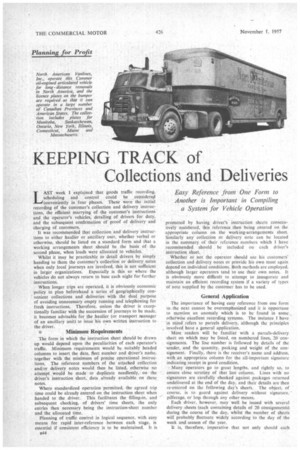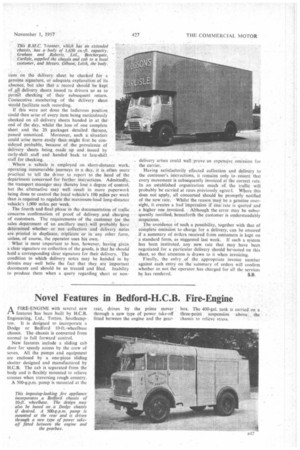KEEPING TRACK of Collections and Deliveries
Page 82

Page 85

If you've noticed an error in this article please click here to report it so we can fix it.
Easy Reference from One Form to Another is Important in Compiling a System for Vehicle Operation
LAST week I explained that goods traffic recording, scheduling and control could be considered conveniently in four phases. These were the initial recording of the customer's collection and delivery instructions, the efficient marrying of the customer's instructions and the operator's vehicles, detailing of drivers for duty. and the subsequent confirmation of proof of delivery and charging of customers.
It was recommended that collection and delivery instructions to either haulier or ancillary user, whether verbal or otherwise, should be listed on a standard form and that a working arrangements sheet should be the basis of the second phase, when loads were allocated to vehicles.
Whilst it may be practicable to detail drivers by simply handing to them the customer's collection or delivery notes when only local journeys are involved, this is not sufficient in larger organizations. Especially is this so where the vehicles do not always return to base each night for further instructions.
When longer trips arc operated, it is obviously economic policy to plan beforehand a series of geographically convenient collections and deliveries with the dual purpose of avoiding unnecessary empty running and telephoning for fresh instructions. Therefore, unless the driver is exceptionally familiar with the succession of journeys to be made. it becomes advisable for the haulier (or transport manager of an ancillary unit) to issue his own written instruction to the driver.
4 Minimum Requirements
The form in which the instruction sheet should be drawn up would depend upon the peculiarities of each operator's traffic. Minimum requirements would be suitably headed columns to insert the date, fleet number and driver's narhe, together with the minimum of precise operational instructions. The reference numbers of the attached collection and/or delivery notes would then be listed, otherwise no attempt would be made to duplicate needlessly, on the driver's instruction sheet, data already available on these notes.
Where standardized operation permitted, the agreed trip time could be already entered on the instruction sheet when handed to the driver. This facilitates the filling-in, and subsequent checking, of drivers' time sheets, the only entries then necessary being the instruction-sheet number and the allocated time.
Planning of traffic control in logical sequence, with easy means for rapid inter-reference between each stage, is essential if consistent efficiency is to be maintained. It is 1344
promoted by having driver's instruction sheets consecutively numbered, this reference then being entered on the appropriate column on the working-arrangements sheet. Similarly any collection or delivery note can be located in the summary of their reference numbers which I have recommended should be included on each driver's instruction sheet.
Whether or not the operator should use his customers' collection and delivery notes or provide his own must again depend on individual conditions. Both methods are employed. although larger operators tend to use their own notes. It is obviously more difficult to attempt to inaugurate and maintain an efficient recording system if a variety of types of note supplied by the customer has to be used.
General Application
The importance of having easy reference from one form to. the next cannot be overemphasized and it is opportune to mention an anomaly which is to be found in some, otherwise excellent recording systems. The instance I have in mind refers to parcels delivery, although the principles involved have a general application.
Most readers will be familiar with a parcels-delivery sheet on which may be listed, on numbered lines, 20 consignments. The line number is followed by details of the sender, and the quantity, packing and weight of the consignment. Finally, there is the receiver's name and address, with an appropriate column for the all-important signature indicating receipt in good condition.
Many operators go to great lengths. and rightly so, to ensure close scrutiny of that last column. Lines with no signatures are carefully checked against packages returned undelivered at the end of the day, and their details are then re-entered on the following day's sheets. The object, of course, is to guard against delivery without signature. ' pilferage, or lo through through any other means.
Each driver, however. may well be issued with several delivery sheets (each containing details of 20 consignments) during the course of the day, whilst the number of sheets will probably fluctuate widely according to the day of the week and season of the year.
It is, therefore, imperative that not only should each
item on the delivery sheet be checked for a genuine signature, or adequate explanation of its absenCe, but also that a record should be kept of _all delivery sheets issued to drivers so as to permit checking of their subsequent return. Consecutive numbering of the delivery sheet Would facilitate such recording.
If this were not done the ludicrous position could then arise of every item being meticulously checked on all delivery sheets handed in at the end of the day, whilst the loss of one complete sheet and the 20 packages detailed thereon, passed unnoticed. Moreover, such a situation could arisemore easily than might first be considered probable, because of the prevalence of delivery, sheets being made up and issued by early-shift :staff and handed back to late-shift
staff for checking. , . •
Where a: _vehicle is employed on short-distancework, operating innumerable journeys in a day, it is often more practical to tell the driver to report to the head of the department concerned for further instructions. Admittedly,. the transport manager may thereby lose a degree of control', but the alternative may well result in more paperwork being done to control the local vehicle's 100 miles--per' week than is.required to regulate the maximum-load long-distance vehicle's 1,000 miles per week.
. The fourth and final phase in the documentation of traffic concerns confirmation of proof of delivery and charging of customers. The requirements of the customer (or the sales department of an ancillary user) will probably have determined whether or not collection and delivery notes are printed in duplicate, triplicate or in any other form, unless, of course, the operator uses his own. _
What is most important to him, however, having given, a clear signature on collection of the goods, is that he should hold a corresponding clear signature for their delivery. The condition in which delivery notes may be habded in by drivers may -well belie the fact that they are important documents and should be so treated and filed. Inability to produce them when a query regarding short or non
delivery arises could well prove an the carrier. expensive omission for
Having satisfactorily effected collection and delivery to the customer's instruetions, it remains only to ensure that every movement is subsequently invoiced at the correct rate. In an established organization much of. the traflic will probably be carried at rates previously agreci. Where this does not apply, all concerned should be promptly notified of the new rate. -Whilst the reason 'may' be a genuine oversight, it creates a bad' impression if one'rate is quoted and a higher one invoiced. . Although the error may be subsequently rectified, henceforth the customer is understandably suspicious. .
The avoidanceof such a possibility, together with that of complete omission to charge for a delivery, can be ensured if a summary of orders received frOm customers is kept on a standard form, as suggested last week. If such a system has been instituted, any new, rate that may have been negotiated for a particular delivery should beomted on this sheet, so that attention is drawn to it when invoicing.
Finally, the entry .of the appropriate invoice number against each entry on the summary of orders will confirm whether or not the operator has charged for all the services he has rendered. &B.
























































































































